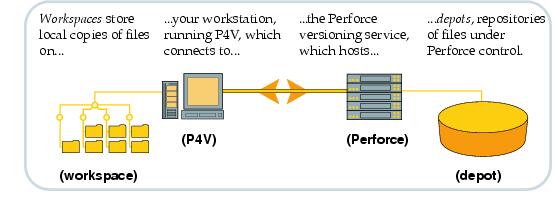About P4V, the Perforce Visual Client
P4V, the Perforce Visual Client, is Perforce's cross-platform graphical user interface. You can use P4V on Windows, Mac, UNIX, and Linux computers and benefit from an identical interface regardless of platform. To use Perforce to manage files, you typically connect to the Perforce versioning service using an application like P4V. P4V enables you to check files in and out, and perform various other versioning tasks.
Basic concepts
Perforce is an enterprise version management tool that you can use to manage source files and other documents, such as multiple revisions of a manual, web pages, or operating system administration files. The files managed by Perforce reside in a depot. To work on files, you open the files and edit them in your workspace. When you're done, you submit changed files to the depot using a changelist. The depot keeps track of all of the current and previous revisions of a file.
Perforce users connect to a shared file repository using a client application like P4V. P4V connects your computer to the Perforce versioning service and helps you move files between Perforce depots and your workspace:

The definitions for these Perforce terms are as follows:
-
Workspace: folders or directories on your workstation where you work on revisions of files that are managed by Perforce.
-
Perforce application: P4V (or another Perforce application, like the command-line client or P4VS, the Microsoft Visual Studio Perforce client), running on your workstation, which makes requests from the Perforce versioning service and delivers the results of those requests (files, status information, and so on) to you.
-
Service: the Perforce versioning service responds to requests from Perforce applications, maintains depot files, and tracks the state of workspaces.
-
Depot: a file repository hosted by the Perforce service. It contains all existing versions of all files ever submitted. Perforce can host multiple depots, but the examples in this guide show a single depot.